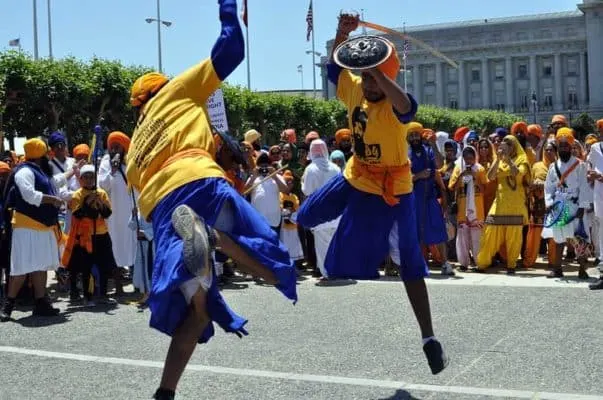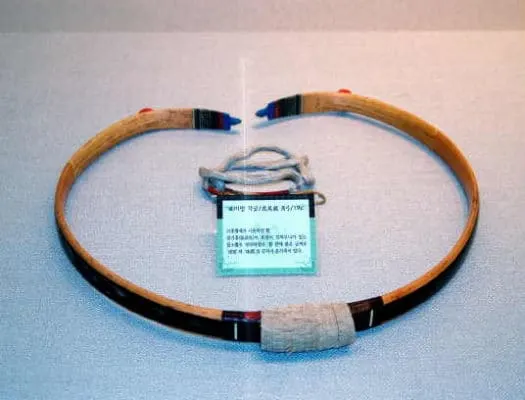
When we think of martial arts, non-weapon based martial arts such as BJJ or Karate comes to our minds first. But what’s often forgotten is that there are just as many weapon-based martial arts as non-weapon based martial arts. Since ancient times, humans have created weapon-based martial arts to prepare combatants to win in wars or in battles. For this reason, weapon-based martial arts played a very crucial role in combat.
In this article, we will focus on weapon-based martial arts and there’s a good chance that you have probably never heard of these weapon-based arts. Keep reading this article to find out the 21 Rare weapon-based martial arts even though they have been created over the centuries, and what is so special about them.
21. Zulu Stick Fighting
Zulu Stick Fighting is an art founded by Nguni people in South Africa. The name means “playing with sticks” which is a great way to get an insight into what this art is all about. Each fighter uses two sticks, one for offense and one for defense while wearing limited armor. Many other forms of this art include shields like “Bantu stick fighting”.
In modern times, Zulu stick fighting is a part of the tradition and culture of South African people. They “fight” in various ceremonies like weddings where two families get into a fight with sticks to get to know each other. There’s even a referee or a “war captain” who is there to keep it all safe and in order.
20. Eskrima
Eskrima is a Filipino martial art that focuses on both weapons and hand to hand fighting. Its students learn how to use kicks, punches, joint locks as well as dirty tactics. But the main focus of the art is on weapons and learning how to handle various ones like:
· Yantok (stick)
· Baraw (Knife)
· Bolo (machete)
· Bankaw (staff)
Eskrima is a versatile fighting system and very good for self-defense. It trains a person for various fighting scenarios they can face on the streets. Students learn how to fight with or without a weapon, and even how to disarm the attacker.
19. Historical Fencing
Most of us know the sport of fencing as a part of the Olympic Games since 1960. But what most people don’t know is that there is a sub-style called “Historical Fencing” that focuses more on real fighting. In this form of fencing, students learn how to handle various types of sharp swords to attack or defend. It is far more effective than the fencing we watch in the Olympics when it comes to self-defense.
In some schools, students also learn how to use various arm locks to disarm the attacker.
18. Sojutsu
Sojutsu is Japanese art and its earliest records date all the way back to the feudal period. The name translates to “art of spear” as the art focuses on a spear called “yari” as the main weapon. Yari is a straight headed spear that has many long and short variations. It was very popular during the feudal period in Japan.
The goal is to learn how to use this weapon both on foot and from horseback. In training, students learn how to block, thrust or stab the opponent. In the feudal period, the big part of the training was learning how to attack the weak spots of samurai warriors. These were the small body areas not covered in armor.
17. Tahtib
Tahtib is an art that emerged in ancient Egypt around 3000 BC. There are a lot of drawings inside the ancient pyramids showing men fighting with sticks that look a lot like tahtib. This makes it one of the oldest martial arts in the world.
The name “tahtib” means the “art of being straight and honest though the use of a stick”. As its name suggests, the main weapon in tahtib is a 4-foot long stick made out of rattan wood. Students learn how to use it to strike or defend all body areas with the emphasis being on targeting the head.
Over the years, Tahtib has moved away from real fighting to folk dancing with wooden sticks. It is still a part of Egyptian culture and usually performed during various ceremonies or to entertain tourists.
16. Siljun Dobup
Siljun Dobup is a sword-based martial art that was created by combining Japanese and Korean traditions. Students learn how to handle a katana sword as well as how to keep high focus while executing cutting techniques.
In training, beginners start by using swords made out of wood due to safety reasons. Once they master all the basics, they go ahead on using sharp swords made out of steel. But, the concept of training doesn’t include any form of sparring. Students practice cutting skills in an exercise called “tameshigiri”.
When it comes to the mental aspects, they also perform various breathing exercises. The goal is to learn how to control breathing and keep the mind calm while performing.
RECOMMENDED FOR YOU: 15 Rare Martial Arts You Have Never Heard of
15. Silambam
Silambam is an Indian art that is among the oldest martial arts in the world. The exact origins of the art are not clear. But according to some sources, the earliest records date all the way back to 1000 BCE. It is an art that focuses on staff made out of bamboo. And the length of each weapon depends on the physical size of the student. Here are the most popular ones:
- Maduvu - this weapon consists of two deer horns pointing in the opposite direction. They are connected with two crossbars which is also a handle of the weapon.
- Arual– this is a type of machete that is usually around 3–6 feet in length.
- Kattari– a short and very sharp knife
- Sedikuchi– this weapon looks a lot like a baseball bat but covered with plenty of small metal balls.
14. Gatka
The exact origins of Gatka are still not clear. But from what we know, this art emerged in ancient India, thousands of years ago. Gatka is an art that focuses on wooden sticks called “soti”. Students use soti to simulate real swords and practice self-defense. We must point up that Gatka has two forms:
- Rasmi or traditional form
- Khel (sport form of Gatka)
This art is also seen as a complete fighting system as it focuses on both mental and physical aspects of combat. It teaches you how to stay calm in a fight and handle various weapons like:
- Talwar (sword)
- Tegh (sword)
- Bagh Nakh (metal craw)
- Barcha (spear)
13. Taiho Jutsu
Taiho Jutsu is a Japanese art used by the feudal police to arrest armed criminals. It has origins in other arts from Japan like “jujutsu”. Back in feudal period, the focus of Taiho Jutsu was on capturing criminals without hurting them. They used various throws and joint locks to subdue the criminal and arrest them. But, they were also skilled in striking as they trained how to throw punches and kicks. The main weapons in this art are:
- Jutte (iron truncheon)
- Tesson (iron fan)
- yori-bo (wooden staff)
- Torinawa (arresting ropes)
12. Gungsol
Gungsol is a Korean martial art that looks a lot like the Japanese art called “Kyudo”. It is an art based on archery and using a composite reflex bow called “Gakgung”. This is a famous weapon we can also find in many other eastern arts. But in Gungsol, students learn how to use this weapon while standing, and riding a horse.

Photo by Historiographer
Gakgung is a weapon made out of wood or water-buffalo horns which is a reason why it is also called “horn bow”. The design is special as it is a highly reflexed bow and both ends of the bow curve away from the archer. This allows archer to create a lot of power and shoot up to 350m (380 yards).
11. Itto-Ryu
Itto-Ryu is a Japanese art that focuses on sword fighting. It has many forms and was a precursor to some modern arts like Kendo. The most famous forms of Itto-Ryu are:
- Enshin
- Kogen
- Hokushin
- Ono-ha
The classes in Itto-Ryu may vary between the schools and forms. But the main structure of the training is very much the same:
- Kata - beginners start by learning basic techniques in a pre-arranged form. They learn basics using a wooden sword called “Iaito”.
- Kumitachi - once students master all the basics, they must apply techniques in a form of sparring. It is a safe part of training as students are still using wooden swords instead of real ones.
- Tameshi Giri - is the last part where students are using real swords called “shinken”. They must drill various cutting skills, learn how to control their breathing, and stay calm.
10. Jojutsu (jodo)
Jojutsu is an art that comes from Okinawan Islands in Japan with the earliest records dating back to the 17th century. The main weapon in jojutsu is a short staff called “jo” which looks very similar to bo staff in “bojutsu”. But, Jo is around 3 to 5 feet long, which means it is much shorter than bo which is around 6 feet long. In modern times, there are two main forms of jojutsu:
- Koryu
- Seitei Jodo
9. Bojutsu
Bojutsu is a Japanese art where students learn how to use sticks as a weapon. The name “Bojutsu” comes from the word “Bo” which means staff or piece of wood, and “jutsu” meaning the art of method. At first, staff may look like a less effective weapon compared to swords for instance. But, this simple weapon is very versatile in the hands of Bojutsu masters.
The main goal of Bojutsu is to use staff as an extension of the limbs. The people who really used Bojutsu was the lower class in feudal Japan. This was during the period when the government allowed only the Samurai class to wear swords.
8. Bataireacht
Bataireacht is an Irish martial art that focuses on stick fighting. It is one of the oldest fighting styles in Europe that was really popular in the 18th century among Irish gangs called “factions”. At the time, the Irish people were under English rule which meant they were not allowed to own any weapons.
But, the Irish realized how they can use simple wooden sticks as a very versatile weapon in a fight. And they could carry these wooden sticks around as the English didn’t see them as a lethal weapon. One of the most popular weapons in Bataireacht is a walking stick. Students learn how to use them to do big damage from both distance, and in close range fighting.
In modern times, this martial art is still a part of Irish culture, and there are many schools in which you can master it.
7. Yabusame
Yabusame is a form of mounted archery that emerged in Japan. Its origins are not clear but the earliest records of this art go all the way back to the 12th century. The goal of the art was to prepare a samurai warrior to use a spear (Yumi) while riding on a horse in a battle. And the way they were training was very unique.
Yabusame archers would ride a horse at full speed across a 300-yard track. The goal was to hit three wooden targets within 20 seconds or less. And they didn’t use just wooden targets as some evidence suggests they were shooting arrows at live dogs. At the time, Yabusame archers were an elite group of warriors that consisted of only the best soldiers.
6. Shintaido
Shintaido is a hybrid martial art created in the 1960s in Japan. The art is a mix of techniques from other arts like karate, kenjutsu and bojutsu into one style. In training, students learn how to fight without weapons using kicks and punches. But they also train how to use various weapons like staff (bo) and wooden swords (bokken).
Even though Shintaido looks like a hard style on paper, it isn’t. The art puts a lot of emphasis on various meditative exercises as the goal is on overcoming oneself. Its students must learn how to perform in a soft and gentle way instead of using sheer force and aggression.
5. Mau Rakau
Mau Rakau is a New Zealand martial art created by Maori people. Most of us know Maori people for their famous “Haka” dance or “war cry of Maori”. This intense dance is the way they show their bravery and warrior spirits. But, they have also created a “Mau Rakau” which is an art that focuses on weapons like:
- Taiaha - this is the most important weapon in Mau Rakau. It is a short spear that is around 1.5 to 1.8 feet long and made out of wood.
- Mere - this weapon is a short club made out of heavy stone or hardwood.
- Patu (club or pounder)
In modern times, Maori people use these weapons as gifts to honor people who showed courage in certain situations. This is one of the ways they keep their history and tradition of the art.
4. Iaido
Iaido is a Japanese martial art created in the 16th century that focuses on sword fighting. The main goal in Iaido is to learn how to draw a sword from a sheath as fast as possible to counter the sudden attacks. Its students use three main weapons in training:
- Bokken
- Iaito
- Shinken
Iaido training doesn’t include sparring and students carry out the moves in pre-arranged forms (kata). It is very popular among older people since training is not hard on your body or cardio intense.
3. Jukendo
Jukendo is an art from Japan created by the military in the 18th century. Even today, most Jukendo students are actually members of the military staff. The art focuses on using a bayonet weapon which is a knife or a short sword. Here are the key elements of training:
- Kihon– this is where students learn offensive and defensive techniques using a bayonet
- Kata– is a part of training where students practice techniques in a pre-arranged form
- Shiai Geiko– is a form of practice where students must wear full Jukendo armor
- Kumite- is a sparring match between the two students
During training and sparring, all students must wear protective gear that consists of:
- Helmet
- Gloves (kote)
- Chest protection (do)
- Hip protector (Tare)
- Urabuton (a piece of thick cotton placed under the left armpit)
2. Krabi-Krabong
Krabi-Krabong is art from Thailand. It is closely related to other arts from this region like Muay Boran. This is mainly because both arts were created around the same time and they have a lot in common. For instance, students learn Muay Boran kicks, punches, trips, and throws. But the emphasis of Krabi-Krabong is on using all kinds of weapons like:
- Krabi (curved sword)
- Daab song mue (double swords)
- Ngao (bladed staff)
- Staff (krabong)
Krabi-Krabong is a very versatile fighting system as it teaches you how to fight both with and without weapons. It prepares a person for just about every fighting scenario in which you have to defend yourself.
1. Kendo
Kendo is a modern Japanese art that has its origins in Itto-Ryu. Instead of real swords, Kendo focuses on using swords made out of bamboo called “shinai” and “bokken”. Students use “shinai” swords for sparring while “bokken” swords are for “kata”. And, they also wear protective armor (bogu) and a uniform (dogi).
“Dogi” is a uniform that consists of a top (keikogi) and trousers (hakama). On the other side, protective gear consists of:
- Helmet
- Body protector (do)
- Gloves (kote)
- Groin and hip protector (tare)
Many other arts are very similar to kendo like “Jukendo” and the Korean art called “Kumbo”. But the biggest difference is that both of these arts use real swords made out of metal.
